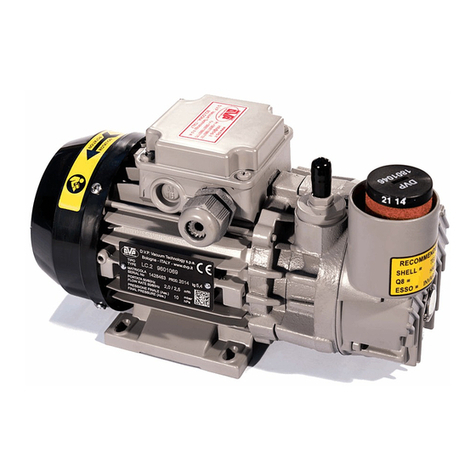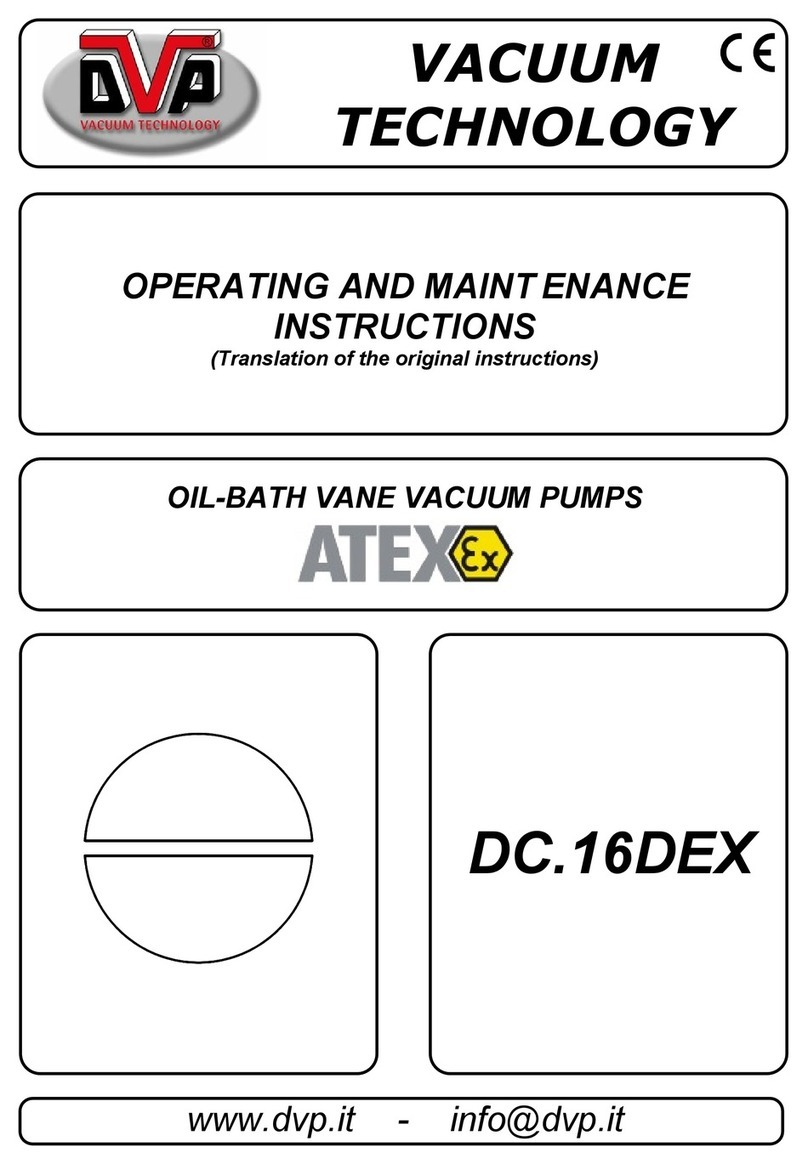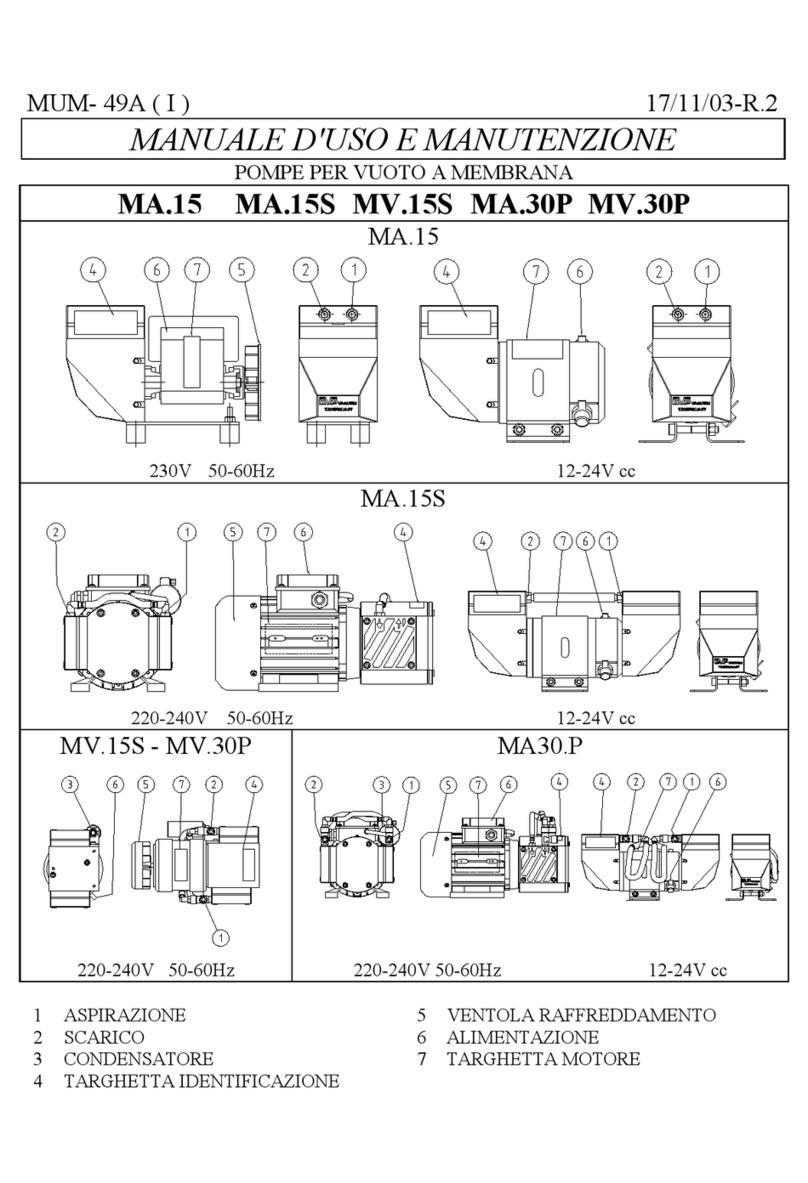
8702013 LV.25 - LB.25 - LB.40 - LB.60 - LC.105 – LC.150 – LC.205 – LC.305 17/05/07 – R.2
Pag. 10 D.V.P. Vacuum Technology s.r.l.
( I ) ( GB )
1 INTRODUZIONE 1 INTRODUCTION
1.1 Scopo del manuale. 1.1 Scope.
Questo manuale illustra le corrette procedure per il disimballo,
l'istallazione l'uso, la manutenzione, l'immagazzinamento e la
rottamazione delle pompe serie L. Prima di iniziare ad operare
leggete attentamente le istruzioni contenute in questo manuale.
Nel manuale sono impiegate due simbologie:
These instructions outline the correct procedures for
unpacking, installing, operating, maintaining, storing and
disposing of the pumps of the L series. Read these instructions
carefully before operating the pumps.
Two symbols are used in these instructions:
La prima si riferisce a istruzioni che se disattese possono
provocare danni alla pompa.
First symbol: failure to comply with these instructions may
lead to pump damage.
La seconda si riferisce a istruzioni che se disattese possono
creare condizioni di pericolo per l'operatore.
Tutte le unità di misura utilizzate nel presente manuale sono
conformi al sistema SI.
Le caratteristiche del prodotto possono variare senza preavviso.
Second symbol: failure to comply with these instructions may
lead to hazards for the operator.
All measuring units used in these instructions are in
accordance with the SI system (International System of units).
Productspecifications are subject to changes without prior notice.
2 SPECIFICHE DI PRODOTTO 2 PRODUCT SPECIFICATIONS
2.1 Caratteristiche elettriche. 2.1 Electrical characteristics.
Le caratteristiche elettriche della pompa sono descritte sulla
targhetta di identificazione del motore elettrico (nr.8).
The electrical characteristics of the pump are reported on the
motor rating plate (no.8).
2.2 Caratteristiche della pompa. 2.2 Pump specifications.
Ulteriori informazioni sulle caratteristiche della pompa sono
riportate nelle tabelle dei dati tecnici.
Further information on the pump specifications are reported in
the technical data table.
3 INSTALLAZIONE 3 INSTALLATION
3.1 Disimballo. 3.1 Unpacking.
Controllate che l'imballo non sia danneggiato, in caso
contrario controllate che la pompa funzioni correttamente.
Make sure packing is not damaged. If not, check that pump
works properly.
In caso di danni inviate reclamo scritto al trasportatore
indicando anche il numero di DDT, data e successivamente
notificate l'inconveniente al venditore.
In the event of damage, send a claim in writing to the
forwarder, reporting the consignment note number and date,
then notify damage to the seller.
3.2 Installazione motore. 3.2 Motor installation.
E’ possibile installare qualunque tipo di motore elettrico o
idraulico che abbia le caratteristiche richieste nella tabella dei
dati tecnici, con flangia e albero corrispondenti alla grandezza:
M100/4 forma B5, secondo le norme IEC-72 per LC.105 ed
LC.150;
M112/4 forma B14, secondo le norme IEC-72 per LC.205;
M132/4 forma B5, secondo le norme IEC-72 per LC.305.
It is possible to install any electric or hydraulic motor that has
the features described in table of technical data, with flange
and shaft corresponding to:
M100/4 - B5 size as per standard IEC-72 for LC.105 and LC.150;
M112/4 - B14 size as per standard IEC-72 for LC.205;
M132/4 - B5 size as per standard IEC-72 for LC.305.
ATTENZIONE: montare il gruppo giunto/ventola sul motore
seguendo le istruzioni seguenti.
Inserire il gruppo giunto/ventola sull’albero motore fino ad
ottenere la quota indicata, quindi serrare la vite A per rendere
solidale il gruppo all’albero motore (vedi figura pag. 3).
WARNING: Install fan/coupling assembly following this
instruction.
Fit the assembly on the motor shaft up to reaching the stated
measure, then tight the A marked screws to firmly fix the
assembly to the shaft (see picture page 3).
3.3 Sistema utilizzatore. 3.3 User system.
Assicuratevi che il sistema utilizzatore non sia contaminato da
sostanze nocive durante le operazioni di installazione.
Make sure that no harmful substances contaminate the user
system during installation.
Montate una valvola di isolamento fra pompa e
sistema se desiderate che questo rimanga in vuoto
anche a pompa ferma. If you wish the system to maintain vacuum even
when pump is stopped, install a cutoff valve
between pump and system.
Assicuratevi che non vengano trasmesse vibrazioni o carichi
sull'attacco della pompa.
Make sure that no vibrations or stresses are transmitted to the
pump connection.
3.4 Alloggiamento. 3.4 Positioning.
Utilizzate appositi stumenti di sollevamento
applicati al golfare (nr.11) per sollevare la
pompa.
Use suitable lifting equipment secured to the
eyebolt (no.11) to lift the pump.

































